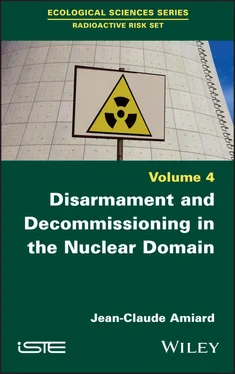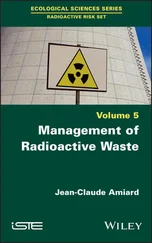South Africa’s only nuclear test likely occurred in 1979. On the night of September 22, 1979, a double flash was spotted off the Prince Edward Islands by the American satellite Vela 6911. The double flash of light is the signature of an atmospheric atomic explosion. The initial flash burst at the start of the explosion and corresponded to a fireball. Then, the glow was obscured for a fraction of a second by the shock wave, which made the atmosphere opaque. Then, when the cloud dissipated, the second flash appeared. Since South Africa was the only power in the region with the means to enrich uranium, it was immediately suspected, but foreign support, possibly Israeli, was also envisaged [BAT 18].
South Africa’s disarmament program was complicated by its division State into two countries (South Africa and Namibia) [DZI 17].
The program to dismantle South Africa’s nuclear program began with the dismantling of the six nuclear weapon devices and the seventh, which was in production. The highly enriched uranium was returned to the AEC to be kept under secure surveillance. The second stage was the complete decontamination of the Armscor installations (1990–1991) and the return of highly contaminated equipment, such as melting furnaces, to the AEC. Advena/Circle’s facilities were converted into commercial civil or military activities, but with conventional weapons: the destruction and disposal of non-nuclear components, as well as engineering design and manufacturing information provisions. South African nuclear officials informed the de Klerk government of an appropriate timetable for the state’s accession to the NPT, the signing of a comprehensive safeguards agreement with the IAEA (International Atomic Energy Agency), and the submission of a complete national inventory of nuclear materials and facilities, as required by the safeguards agreement. Finally, the closure of plant Y was to take place as soon as possible [ALB 16].
Other countries have developed nuclear programs in the past: Brazil, Algeria, Libya, Ukraine, Sweden, Belarus and Kazakhstan, but have abandoned nuclear deterrence.
1.3.4. Failures of the NPT
Despite the NPT’s entry into force, four countries have since acquired atomic weapons (Israel, India, Pakistan and North Korea).
Israel has always used deliberately ambiguous language with respect to nuclear weapons and has refused to sign the NPT. The only public revelation of Israel’s nuclear capabilities was made by a former Dimona nuclear power plant technician, Mordechai Vanunu, in the Sunday Times on October 5, 1986 [COH 05].
Historically, Israel benefited from French aid, between 1956 and 1961, for scientific advice for the construction of the Dimona reactor, as well as the supply of many nuclear materials by the British between 1950 and 1960. Between 1961 and 1969, American experts visited Israeli installations, but with advanced notice of their arrival. This made it possible to camouflage the real activities of the installations. In 1969, President Richard Nixon agreed to allow Israel to possess nuclear weapons, on the condition that it would not conduct nuclear tests or display its nuclear warheads [COH 98, BIA 09, COH 10, TÉN 10].
No nuclear tests have been officially recognized. However, it is possible that an underground test took place in 1963 in the Negev desert, as well as a 3 kt atmospheric test in 1979 in South African waters, in collaboration with South Africa (double Vela flash). Indeed, on September 22, 1979, the American satellite Vela 6911 detected an optical signal characteristic of an atmospheric nuclear explosion over the southern Indian or Atlantic Ocean. Weiss believes that the flash was an Israeli nuclear test assisted by South Africa [WEI 11]. In a new analysis of radionuclide and hydroacoustic data, it was concluded that the double flash resulted from a low-yield nuclear weapon test [DEG 18]. Among the evidence put forward by these authors, the concentration of iodine-131 found in the thyroids of some Australian sheep could suggest that they had grazed grass in the path of a potential radioactive fallout plume from this test.
In September 1996, when the Comprehensive Test Ban Treaty was signed, it was reasonable to believe that this would become a general rule of behavior accepted by all states. However, in May 1998, India and Pakistan defied the international community by conducting nuclear tests. Faced with the new risk of a regional nuclear conflict involving Kashmir in particular, the Western powers needed to integrate these two states into the nuclear non-proliferation regime. There were only two ways to do this: sanctions or dialogue. However, India and Pakistan were no longer ordinary states that could be dictated to. They had become nuclear powers with all that this implies in terms of prestige and political weight on the international scene [CAP 98].
India developed a nuclear program as soon as it gained independence in 1948, with the adoption of the Atomic Energy Act, aimed at developing nuclear energy for peaceful purposes. Today, India is not a signatory to the Nuclear Non-Proliferation Treaty (NPT), but has more than 20 nuclear reactors, mainly Canadian-designed CANDU pressurized heavy water reactors.
India’s Atomic Energy Commission detonated its first underground nuclear weapon, the Smiling Buddha, at a depth of 100 meters in Pokharan on May 18, 1974. This led to the cessation of all forms of international cooperation in favor of India’s civilian program and exclusion from the Nuclear Non-Proliferation Treaty (NPT). Subsequent nuclear tests took place underground on May 11 and 13, 1998. India conducted three tests on May 11, testing an A-bomb and an H-bomb, and two more tests on May 13, using small charges [CAP 98]. In 2018, the Indian Nuclear Deterrent Air Force had 48 nuclear warhead-launching aircrafts, 60 ground-based ballistic missiles, and about 18 cruise missiles for a total of 130–140 nuclear bombs [KRI 18a].
Pakistan (Islamic Republic) began its nuclear program in January 1972. This program was originally a response to India’s development of nuclear weapons. The military nuclear program began in 1987. Pakistan’s first underground nuclear test was conducted on May 28, 1998, codename Chagai-I (Chagai district, Balochistan province). This test was a series of five low-power nuclear tests. The second test (Chagai-II), took place in the Kharan desert two days later. The power was equivalent to 12 kt of TNT. Of the six tests, one used plutonium and the others used enriched uranium. Pakistan, which is not a signatory of the Treaty on the Non-Proliferation of Nuclear Weapons (NPT), thus became the seventh country in the world to develop and test nuclear weapons and is also the only Muslim country to possess nuclear weapons.
Its capacities have not been made public, leading to estimates. Thus, in 2013, one source indicated that the Pakistani armed forces possessed 300 to 350 nuclear warheads (Le Monde, June 3, 2013), compared to around 50 in 2007, while SIPRI estimated Pakistan’s arsenal to be 250 to 300 warheads in 2017, much higher than India [GAI 17, SIP 18].
The Indian and Pakistani nuclear programs can be explained by the exacerbated rivalry between the two states. In addition, the Pakistani nuclear physicist A.Q. Khan, has established strong nuclear proliferation ties with Iran, North Korea and Libya because of his personal motivations, religious orientation and anti-Western worldview [ABB 18]. The Pakistani people were overcome with fever dreams for the future and were very proud after the first atomic tests. However, in India, the population was more reserved about the Indian tests and regretted the practice of secrecy in this field [ABR 09].
The third failure of the NPT is that of North Korea, which after signing the treaty withdrew from it. In October 2006, North Korea announced that it had detonated its first nuclear bomb. Other tests were carried out in 2009, 2013, 2016 and 2017. The best estimate of the stocks of highly enriched uranium (HEU) in the Yongbyon nuclear complex at the end of 2015 were between 75 and 320 kg [BRA 18].
Читать дальше











